北师大版(2019)必修第一册Unit 3 Celebrations Lesson 1 Spring Festival学案
文档属性
| 名称 | 北师大版(2019)必修第一册Unit 3 Celebrations Lesson 1 Spring Festival学案 | 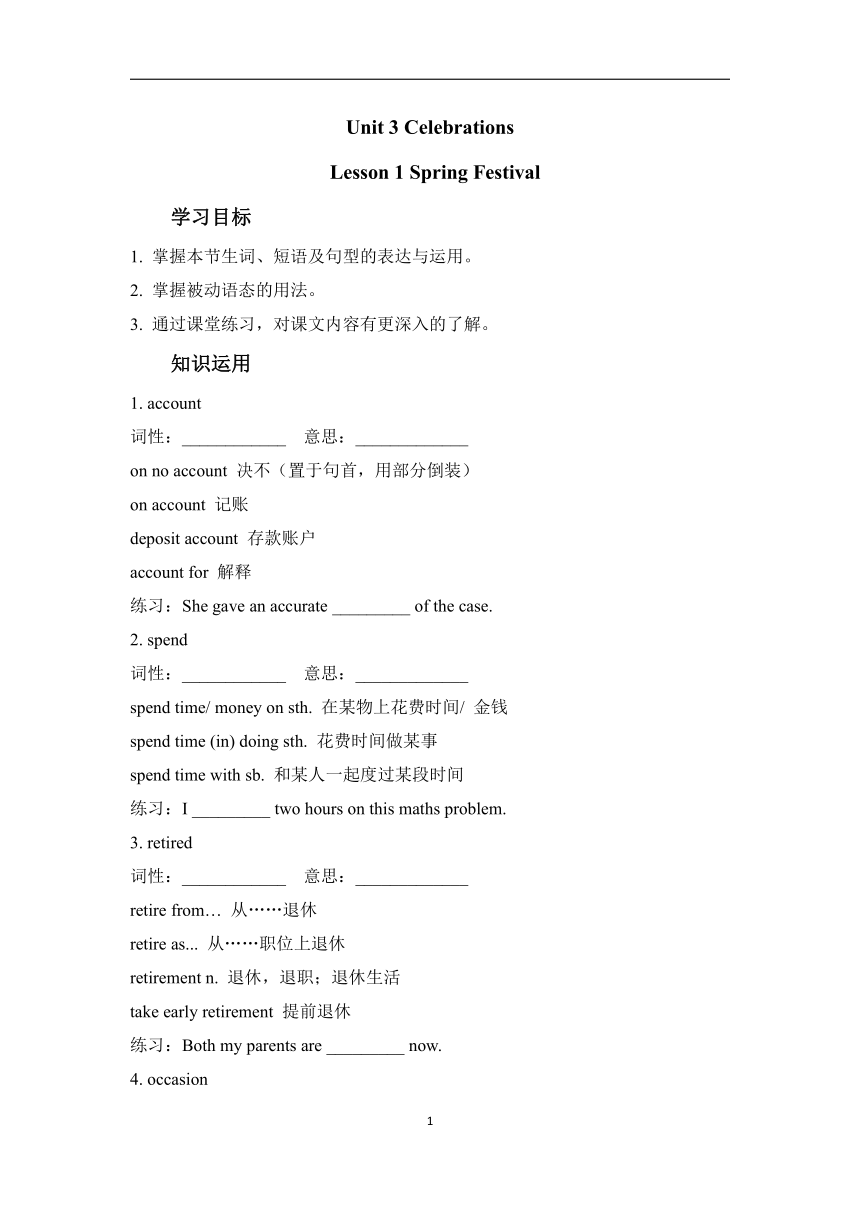 | |
| 格式 | docx | ||
| 文件大小 | 37.9KB | ||
| 资源类型 | 教案 | ||
| 版本资源 | 北师大版(2019) | ||
| 科目 | 英语 | ||
| 更新时间 | 2022-11-21 16:13:50 | ||
图片预览

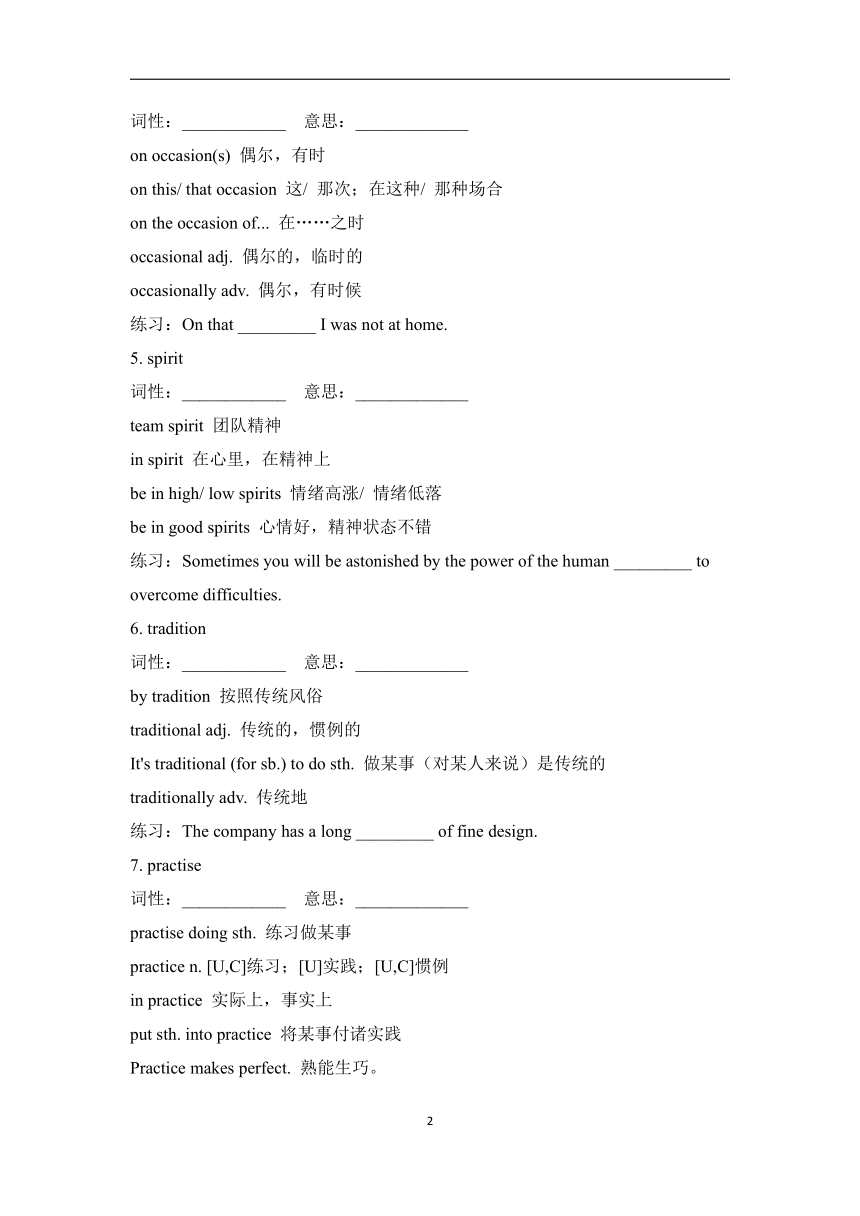
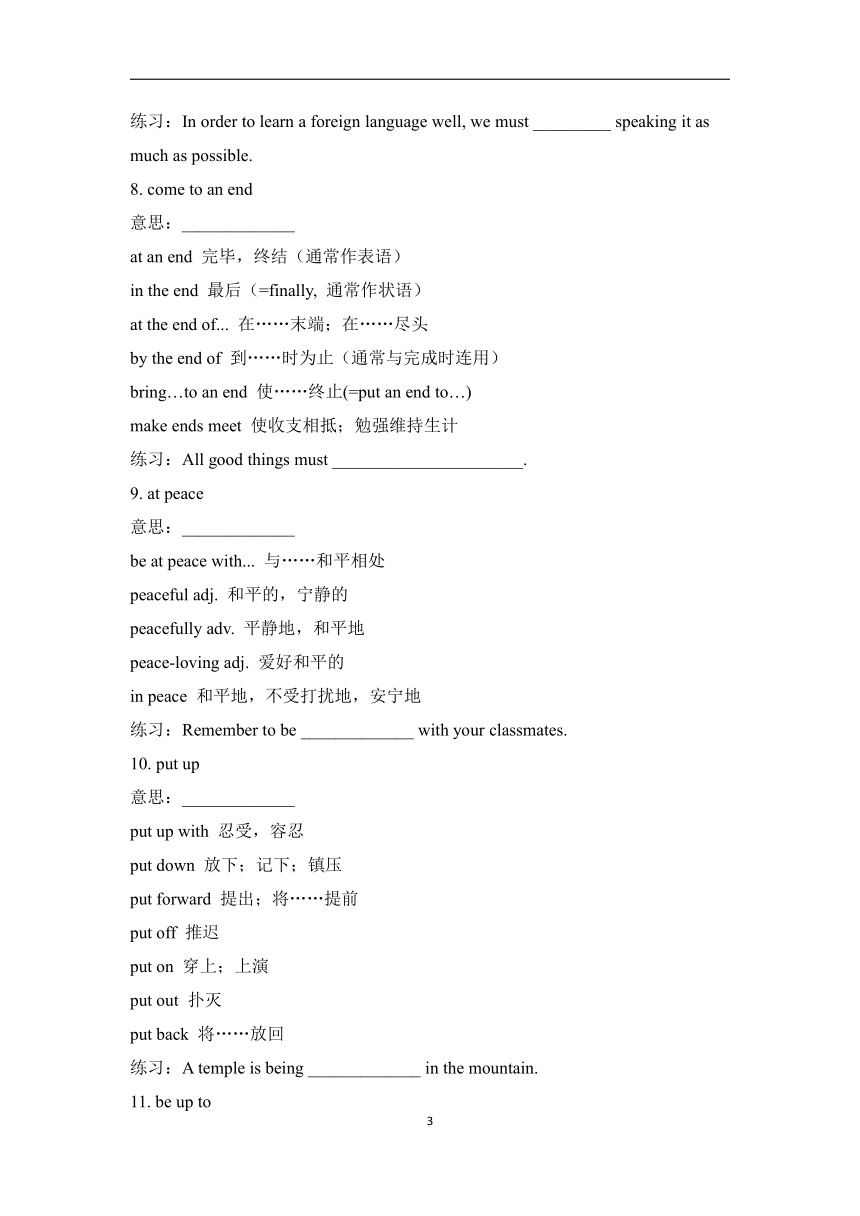
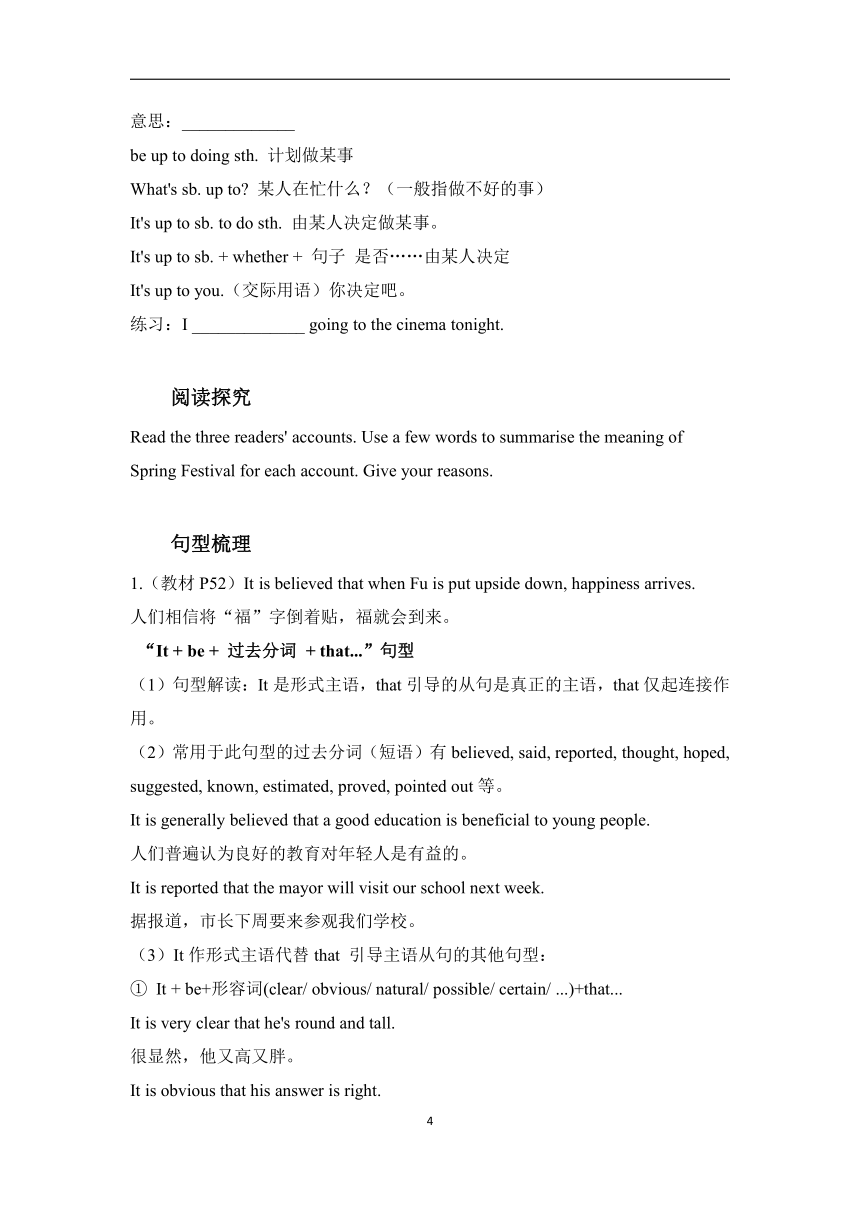
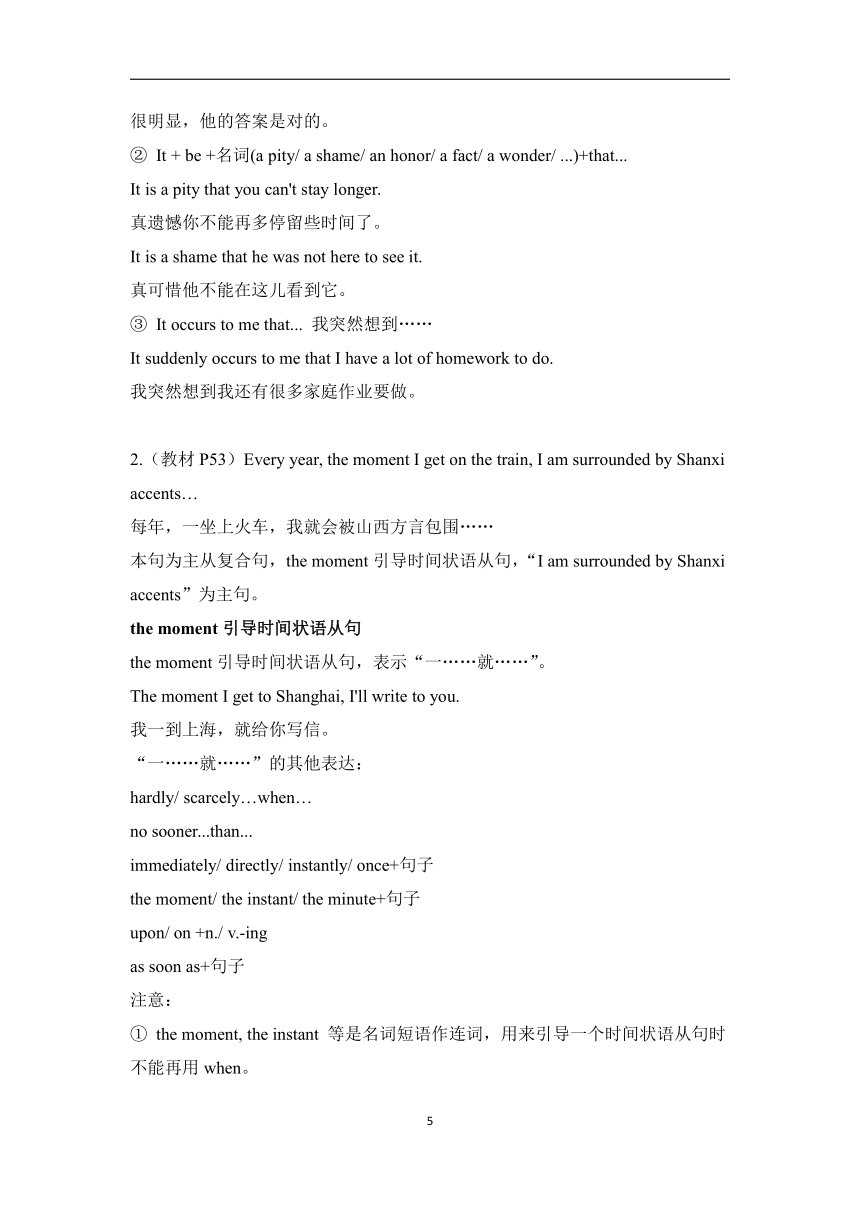
文档简介
Unit 3 Celebrations
Lesson 1 Spring Festival
学习目标
1. 掌握本节生词、短语及句型的表达与运用。
2. 掌握被动语态的用法。
3. 通过课堂练习,对课文内容有更深入的了解。
知识运用
1. account
词性:____________ 意思:_____________
on no account 决不(置于句首,用部分倒装)
on account 记账
deposit account 存款账户
account for 解释
练习:She gave an accurate _________ of the case.
2. spend
词性:____________ 意思:_____________
spend time/ money on sth. 在某物上花费时间/ 金钱
spend time (in) doing sth. 花费时间做某事
spend time with sb. 和某人一起度过某段时间
练习:I _________ two hours on this maths problem.
3. retired
词性:____________ 意思:_____________
retire from… 从……退休
retire as... 从……职位上退休
retirement n. 退休,退职;退休生活
take early retirement 提前退休
练习:Both my parents are _________ now.
4. occasion
词性:____________ 意思:_____________
on occasion(s) 偶尔,有时
on this/ that occasion 这/ 那次;在这种/ 那种场合
on the occasion of... 在……之时
occasional adj. 偶尔的,临时的
occasionally adv. 偶尔,有时候
练习:On that _________ I was not at home.
5. spirit
词性:____________ 意思:_____________
team spirit 团队精神
in spirit 在心里,在精神上
be in high/ low spirits 情绪高涨/ 情绪低落
be in good spirits 心情好,精神状态不错
练习:Sometimes you will be astonished by the power of the human _________ to overcome difficulties.
6. tradition
词性:____________ 意思:_____________
by tradition 按照传统风俗
traditional adj. 传统的,惯例的
It's traditional (for sb.) to do sth. 做某事(对某人来说)是传统的
traditionally adv. 传统地
练习:The company has a long _________ of fine design.
7. practise
词性:____________ 意思:_____________
practise doing sth. 练习做某事
practice n. [U,C]练习;[U]实践;[U,C]惯例
in practice 实际上,事实上
put sth. into practice 将某事付诸实践
Practice makes perfect. 熟能生巧。
练习:In order to learn a foreign language well, we must _________ speaking it as much as possible.
8. come to an end
意思:_____________
at an end 完毕,终结(通常作表语)
in the end 最后(=finally, 通常作状语)
at the end of... 在……末端;在……尽头
by the end of 到……时为止(通常与完成时连用)
bring…to an end 使……终止(=put an end to…)
make ends meet 使收支相抵;勉强维持生计
练习:All good things must ______________________.
9. at peace
意思:_____________
be at peace with... 与……和平相处
peaceful adj. 和平的,宁静的
peacefully adv. 平静地,和平地
peace-loving adj. 爱好和平的
in peace 和平地,不受打扰地,安宁地
练习:Remember to be _____________ with your classmates.
10. put up
意思:_____________
put up with 忍受,容忍
put down 放下;记下;镇压
put forward 提出;将……提前
put off 推迟
put on 穿上;上演
put out 扑灭
put back 将……放回
练习:A temple is being _____________ in the mountain.
11. be up to
意思:_____________
be up to doing sth. 计划做某事
What's sb. up to 某人在忙什么?(一般指做不好的事)
It's up to sb. to do sth. 由某人决定做某事。
It's up to sb. + whether + 句子 是否……由某人决定
It's up to you.(交际用语)你决定吧。
练习:I _____________ going to the cinema tonight.
阅读探究
Read the three readers' accounts. Use a few words to summarise the meaning of Spring Festival for each account. Give your reasons.
句型梳理
1.(教材P52)It is believed that when Fu is put upside down, happiness arrives.
人们相信将“福”字倒着贴,福就会到来。
“It + be + 过去分词 + that...”句型
(1)句型解读:It是形式主语,that引导的从句是真正的主语,that仅起连接作用。
(2)常用于此句型的过去分词(短语)有believed, said, reported, thought, hoped, suggested, known, estimated, proved, pointed out等。
It is generally believed that a good education is beneficial to young people.
人们普遍认为良好的教育对年轻人是有益的。
It is reported that the mayor will visit our school next week.
据报道,市长下周要来参观我们学校。
(3)It作形式主语代替that 引导主语从句的其他句型:
① It + be+形容词(clear/ obvious/ natural/ possible/ certain/ ...)+that...
It is very clear that he's round and tall.
很显然,他又高又胖。
It is obvious that his answer is right.
很明显,他的答案是对的。
② It + be +名词(a pity/ a shame/ an honor/ a fact/ a wonder/ ...)+that...
It is a pity that you can't stay longer.
真遗憾你不能再多停留些时间了。
It is a shame that he was not here to see it.
真可惜他不能在这儿看到它。
③ It occurs to me that... 我突然想到……
It suddenly occurs to me that I have a lot of homework to do.
我突然想到我还有很多家庭作业要做。
2.(教材P53)Every year, the moment I get on the train, I am surrounded by Shanxi accents…
每年,一坐上火车,我就会被山西方言包围……
本句为主从复合句,the moment引导时间状语从句,“I am surrounded by Shanxi accents”为主句。
the moment引导时间状语从句
the moment引导时间状语从句,表示“一……就……”。
The moment I get to Shanghai, I'll write to you.
我一到上海,就给你写信。
“一……就……”的其他表达:
hardly/ scarcely…when…
no sooner...than...
immediately/ directly/ instantly/ once+句子
the moment/ the instant/ the minute+句子
upon/ on +n./ v.-ing
as soon as+句子
注意:
① the moment, the instant 等是名词短语作连词,用来引导一个时间状语从句时不能再用when。
② 在“no sooner...than...”和“hardly/ scarcely...when...”句型中,主句应用过去完成时,从句用一般过去时。当no sooner/ hardlly/ scarcely位于句首时,主句要用部分倒装结构。
3.(教材P53)What's important is who we eat it with.
重要的是我们和谁一起吃。
What 引导主语从句,在主语从句中既作连接词,又作主语;who引导表语从句,在从句中作with的宾语。
what 引导主语从句
what 引导主语从句时既有一定的含义,又起连接作用,常在从句中充当主语、宾语或表语。
What is worth doing is worth doing well.
凡是值得做的事就值得把它做好。(what 在主语从句中作主语)
What I believe is that he will achieve success sooner or later.
我相信他迟早会成功的。(what在主语从句中作宾语)
What the kind man's name is remains unknown to us.
那位好心人叫什么名字我们仍然不知道。(what在主语从句中作表语)
4.(教材P53)Our grandchildren run around shouting and playing…
孙儿辈跑来跑去嬉戏玩耍……
shouting and playing为现在分词作伴随状语。
现在分词(短语)作伴随状语
现在分词(短语)作伴随状语的用法如下:
(1)现在分词(短语)作伴随状语时,分词(短语)所表示的动作的发出者就是句子的主语,且构成现在分词的动词与句子的主语之间为逻辑上的主谓关系。
(2)现在分词(短语)所表示的动作是伴随着句子谓语动词所表示的动作而发生或存在的,是主语的另一个较次要的动作。
(3)现在分词(短语)作伴随状语时通常位于句末,没有相应的状语从句可以替换,但它可以转换成一个并列句。
The children ran out of the room laughing and talking happily.
孩子们跑出房间,愉快地谈笑着。
He sat in the armchair, reading a newspaper.
=He sat in the armchair and read a newspaper.
他坐在扶手椅上读报。
He lay awake all night, thinking about the problem.
= He lay awake all night and thought about the problem.
他躺了一夜没睡着,思考着那个问题。
语法解析
语法:被动语态
英语有两种语态:主动语态和被动语态。主动语态表示主语是谓语动作的执行者;被动语态表示主语是谓语动作的承受者,其结构为:be+过去分词。在被动语态中,动作的执行者常跟在by后。
1. 被动语态的使用场合、形式及特殊情况
被动语态是动词的一种特殊形式,表示句子的主语是动作的承受者,即动作的对象。一般来说,只有需要动作对象的及物动词才有被动语态,不及物动词没有被动语态。
(1)被动语态的使用场合
① 不知道或没必要说明动作的执行者
Do you know when the new railway will be opened
你知道新铁路什么时候通车吗?
② 强调动作的承受者
The novel was written by the high school student.
这部小说是这个高中生写的。
③ 表示委婉或礼貌,避免提及动作的执行者
You are cordially invited to a party to be held at the Workers' Club at 7 p.m. on May 1.
热情邀请您参加5月1日晚上7点在工人俱乐部举行的聚会。
④ 修辞需要,为了使句子简练
She stepped onto the stage and was warmly applauded by the audience.
她走上舞台,观众给予了热烈的掌声。
(2)被动语态的形式:被动语态的时态、人称和数的变化(以动词do为例):
一般式 进行式 完成式
现在 am/ is/ are done am/ is/ are being done has/ have been done
过去 was/ were done was/ were being done had been done
将来 will/ shall be done will/ shall have been done
Rice is grown in the south of the US.
水稻在美国南部种植。
I'm afraid I am being followed.
恐怕我正在被人跟踪。
The plan was generally considered not practical.
人们普遍认为这个计划不切实际。
被动语态除了用“be+过去分词”结构外,还可用“get +过去分词”结构。这种结构多用于口语中,强调动作的结果,动作的执行者一般不表示出来。
The boy got hurt when he was riding to school.
那个男孩骑车上学时受伤了。
(3)被动语态的特殊情况
① 含有情态动词的被动语态
构成:情态动词+be+过去分词。
All the letters should be answered immediately.
所有的信件都应立刻回复。
② 不定式的被动语态
一般式 (to be done):表示不定式动作发生在谓语动作之后或与其(几乎)同时发生
完成式 (to have been done):表示不定式动作发生在谓语动作之前
The book is said to be published soon.
据说这本书很快就会出版。
The book is said to have been translated into many languages.
据说这本书已被译成很多种语言。
③ 接双宾语的动词变被动语态
有些动词在主动语态中常接双宾语,即直接宾语(一般指物)和间接宾语(一般指人)。在变为被动语态时,如果间接宾语被提前作主语,那么直接宾语保留不变;如果直接宾语被提前作主语,那么间接宾语前一般要加上相应的介词to或for。
We gave him the letter.
= He was given the letter by us.
= The letter was given to him by us.
我们把那封信给他了。
She bought her mother a new coat.
= Her mother was bought a new coat by her.
= A new coat was bought for her mother by her.
她给她妈妈买了一件新大衣。
④ 接复合结构的动词变被动语态
应将宾语变为被动句的主语,而宾语补足语保留不动(此时宾语补足语变为主语补足语)。
We elected him our monitor.
= He was elected our monitor by us.
我们选他当我们的班长。
2. 主动形式表示被动意义
(1)连系动词(如 look, sound, smell, feel, taste, remain等)后接表语时,一般用主动形式表示被动意义。
Your advice sounds practical.
你的建议听起来切实可行。
Whether we can have a holiday remains unknown.
我们是否有假期还不知道。
The material feels very soft.
这种材料摸起来很柔软。
The cake tastes very delicious.
这个蛋糕尝起来很美味。
(2)read, write, wash, sell, wear, cook, lock, shut, open, drink 等表示主语的某种属性特征的动词,通常用主动形式表示被动意义,其后常用副词修饰。
The book sells quickly.
这本书卖得快。
(3)表示开始、结束、运动的动词(如begin, start, end, finish, close, stop, move, run等)通常用主动形式表示被动意义。
The shop closes at 6 p.m. every day.
这家商店每天下午6点关门。
3. 使用被动语态应注意的问题
(1)不及物动词(短语)无被动语态。常见的不及物动词(短语)有appear, die, disappear, fail, happen, lie, remain, break out, come true, fall asleep, keep silent, lose heart, take place, run out等。
We cannot say for sure what will happen.
我们无法确定会发生什么事。
(2)在主动语态里,动词see, make, hear, watch, notice等后面作宾语补足语的动词不定式不带to,但变为被动语态时,必须补上to。
They made him go there alone.
他们让他独自去那里。(主动语态)
He was made to go there alone by them.
他们让他独自去那里。(被动语态)
(3)带介词或副词的动词短语(如 look after, put on, pay attention to)用于被动语态时,它们原来所带的介词或副词应保留下来。
She often looks after the old man.
她经常照顾那位老人。(主动语态)
The old man is often looked after by her.
她经常照顾那位老人。(被动语态)
练习:
1. He usually gets ___________ (pay) by the hour.
2. The first railway in the world ___________ (design) in the last century.
3. Five units of this textbook ___________ (study) by the end of last month.
4. After school we went to the reading room to do some reading, only to be told that it ___________ (decorate).
5. Look! A nice picture ___________ (draw) by our teacher.
6. In this forest, over 50% of the trees ___________ (damage) so far.
7. Come and sit down by the fire. Your hands ___________ (feel) so cold.
8. The parts of a museum open to the public ___________ (call) galleries or rooms.
答案
知识运用
1. account 2. spent 3. retired 4. pay off 5. spirit 6. tradition 7. practice
8. come to an end 9. at peace 10. put up 11. am up to
阅读探究
For Tom, Spring Festival means excitement and a lot of fun.
For Xu Gang, coming home and being with his entire family is the most important part of the Spring Festival.
For Li Yan, Spring Festival is family time.
语法解析
1. paid 2. was designed 3. had been studied 4. was being decorated
5. is being drawn 6. have been damaged 7. feel 8. are called
2
Lesson 1 Spring Festival
学习目标
1. 掌握本节生词、短语及句型的表达与运用。
2. 掌握被动语态的用法。
3. 通过课堂练习,对课文内容有更深入的了解。
知识运用
1. account
词性:____________ 意思:_____________
on no account 决不(置于句首,用部分倒装)
on account 记账
deposit account 存款账户
account for 解释
练习:She gave an accurate _________ of the case.
2. spend
词性:____________ 意思:_____________
spend time/ money on sth. 在某物上花费时间/ 金钱
spend time (in) doing sth. 花费时间做某事
spend time with sb. 和某人一起度过某段时间
练习:I _________ two hours on this maths problem.
3. retired
词性:____________ 意思:_____________
retire from… 从……退休
retire as... 从……职位上退休
retirement n. 退休,退职;退休生活
take early retirement 提前退休
练习:Both my parents are _________ now.
4. occasion
词性:____________ 意思:_____________
on occasion(s) 偶尔,有时
on this/ that occasion 这/ 那次;在这种/ 那种场合
on the occasion of... 在……之时
occasional adj. 偶尔的,临时的
occasionally adv. 偶尔,有时候
练习:On that _________ I was not at home.
5. spirit
词性:____________ 意思:_____________
team spirit 团队精神
in spirit 在心里,在精神上
be in high/ low spirits 情绪高涨/ 情绪低落
be in good spirits 心情好,精神状态不错
练习:Sometimes you will be astonished by the power of the human _________ to overcome difficulties.
6. tradition
词性:____________ 意思:_____________
by tradition 按照传统风俗
traditional adj. 传统的,惯例的
It's traditional (for sb.) to do sth. 做某事(对某人来说)是传统的
traditionally adv. 传统地
练习:The company has a long _________ of fine design.
7. practise
词性:____________ 意思:_____________
practise doing sth. 练习做某事
practice n. [U,C]练习;[U]实践;[U,C]惯例
in practice 实际上,事实上
put sth. into practice 将某事付诸实践
Practice makes perfect. 熟能生巧。
练习:In order to learn a foreign language well, we must _________ speaking it as much as possible.
8. come to an end
意思:_____________
at an end 完毕,终结(通常作表语)
in the end 最后(=finally, 通常作状语)
at the end of... 在……末端;在……尽头
by the end of 到……时为止(通常与完成时连用)
bring…to an end 使……终止(=put an end to…)
make ends meet 使收支相抵;勉强维持生计
练习:All good things must ______________________.
9. at peace
意思:_____________
be at peace with... 与……和平相处
peaceful adj. 和平的,宁静的
peacefully adv. 平静地,和平地
peace-loving adj. 爱好和平的
in peace 和平地,不受打扰地,安宁地
练习:Remember to be _____________ with your classmates.
10. put up
意思:_____________
put up with 忍受,容忍
put down 放下;记下;镇压
put forward 提出;将……提前
put off 推迟
put on 穿上;上演
put out 扑灭
put back 将……放回
练习:A temple is being _____________ in the mountain.
11. be up to
意思:_____________
be up to doing sth. 计划做某事
What's sb. up to 某人在忙什么?(一般指做不好的事)
It's up to sb. to do sth. 由某人决定做某事。
It's up to sb. + whether + 句子 是否……由某人决定
It's up to you.(交际用语)你决定吧。
练习:I _____________ going to the cinema tonight.
阅读探究
Read the three readers' accounts. Use a few words to summarise the meaning of Spring Festival for each account. Give your reasons.
句型梳理
1.(教材P52)It is believed that when Fu is put upside down, happiness arrives.
人们相信将“福”字倒着贴,福就会到来。
“It + be + 过去分词 + that...”句型
(1)句型解读:It是形式主语,that引导的从句是真正的主语,that仅起连接作用。
(2)常用于此句型的过去分词(短语)有believed, said, reported, thought, hoped, suggested, known, estimated, proved, pointed out等。
It is generally believed that a good education is beneficial to young people.
人们普遍认为良好的教育对年轻人是有益的。
It is reported that the mayor will visit our school next week.
据报道,市长下周要来参观我们学校。
(3)It作形式主语代替that 引导主语从句的其他句型:
① It + be+形容词(clear/ obvious/ natural/ possible/ certain/ ...)+that...
It is very clear that he's round and tall.
很显然,他又高又胖。
It is obvious that his answer is right.
很明显,他的答案是对的。
② It + be +名词(a pity/ a shame/ an honor/ a fact/ a wonder/ ...)+that...
It is a pity that you can't stay longer.
真遗憾你不能再多停留些时间了。
It is a shame that he was not here to see it.
真可惜他不能在这儿看到它。
③ It occurs to me that... 我突然想到……
It suddenly occurs to me that I have a lot of homework to do.
我突然想到我还有很多家庭作业要做。
2.(教材P53)Every year, the moment I get on the train, I am surrounded by Shanxi accents…
每年,一坐上火车,我就会被山西方言包围……
本句为主从复合句,the moment引导时间状语从句,“I am surrounded by Shanxi accents”为主句。
the moment引导时间状语从句
the moment引导时间状语从句,表示“一……就……”。
The moment I get to Shanghai, I'll write to you.
我一到上海,就给你写信。
“一……就……”的其他表达:
hardly/ scarcely…when…
no sooner...than...
immediately/ directly/ instantly/ once+句子
the moment/ the instant/ the minute+句子
upon/ on +n./ v.-ing
as soon as+句子
注意:
① the moment, the instant 等是名词短语作连词,用来引导一个时间状语从句时不能再用when。
② 在“no sooner...than...”和“hardly/ scarcely...when...”句型中,主句应用过去完成时,从句用一般过去时。当no sooner/ hardlly/ scarcely位于句首时,主句要用部分倒装结构。
3.(教材P53)What's important is who we eat it with.
重要的是我们和谁一起吃。
What 引导主语从句,在主语从句中既作连接词,又作主语;who引导表语从句,在从句中作with的宾语。
what 引导主语从句
what 引导主语从句时既有一定的含义,又起连接作用,常在从句中充当主语、宾语或表语。
What is worth doing is worth doing well.
凡是值得做的事就值得把它做好。(what 在主语从句中作主语)
What I believe is that he will achieve success sooner or later.
我相信他迟早会成功的。(what在主语从句中作宾语)
What the kind man's name is remains unknown to us.
那位好心人叫什么名字我们仍然不知道。(what在主语从句中作表语)
4.(教材P53)Our grandchildren run around shouting and playing…
孙儿辈跑来跑去嬉戏玩耍……
shouting and playing为现在分词作伴随状语。
现在分词(短语)作伴随状语
现在分词(短语)作伴随状语的用法如下:
(1)现在分词(短语)作伴随状语时,分词(短语)所表示的动作的发出者就是句子的主语,且构成现在分词的动词与句子的主语之间为逻辑上的主谓关系。
(2)现在分词(短语)所表示的动作是伴随着句子谓语动词所表示的动作而发生或存在的,是主语的另一个较次要的动作。
(3)现在分词(短语)作伴随状语时通常位于句末,没有相应的状语从句可以替换,但它可以转换成一个并列句。
The children ran out of the room laughing and talking happily.
孩子们跑出房间,愉快地谈笑着。
He sat in the armchair, reading a newspaper.
=He sat in the armchair and read a newspaper.
他坐在扶手椅上读报。
He lay awake all night, thinking about the problem.
= He lay awake all night and thought about the problem.
他躺了一夜没睡着,思考着那个问题。
语法解析
语法:被动语态
英语有两种语态:主动语态和被动语态。主动语态表示主语是谓语动作的执行者;被动语态表示主语是谓语动作的承受者,其结构为:be+过去分词。在被动语态中,动作的执行者常跟在by后。
1. 被动语态的使用场合、形式及特殊情况
被动语态是动词的一种特殊形式,表示句子的主语是动作的承受者,即动作的对象。一般来说,只有需要动作对象的及物动词才有被动语态,不及物动词没有被动语态。
(1)被动语态的使用场合
① 不知道或没必要说明动作的执行者
Do you know when the new railway will be opened
你知道新铁路什么时候通车吗?
② 强调动作的承受者
The novel was written by the high school student.
这部小说是这个高中生写的。
③ 表示委婉或礼貌,避免提及动作的执行者
You are cordially invited to a party to be held at the Workers' Club at 7 p.m. on May 1.
热情邀请您参加5月1日晚上7点在工人俱乐部举行的聚会。
④ 修辞需要,为了使句子简练
She stepped onto the stage and was warmly applauded by the audience.
她走上舞台,观众给予了热烈的掌声。
(2)被动语态的形式:被动语态的时态、人称和数的变化(以动词do为例):
一般式 进行式 完成式
现在 am/ is/ are done am/ is/ are being done has/ have been done
过去 was/ were done was/ were being done had been done
将来 will/ shall be done will/ shall have been done
Rice is grown in the south of the US.
水稻在美国南部种植。
I'm afraid I am being followed.
恐怕我正在被人跟踪。
The plan was generally considered not practical.
人们普遍认为这个计划不切实际。
被动语态除了用“be+过去分词”结构外,还可用“get +过去分词”结构。这种结构多用于口语中,强调动作的结果,动作的执行者一般不表示出来。
The boy got hurt when he was riding to school.
那个男孩骑车上学时受伤了。
(3)被动语态的特殊情况
① 含有情态动词的被动语态
构成:情态动词+be+过去分词。
All the letters should be answered immediately.
所有的信件都应立刻回复。
② 不定式的被动语态
一般式 (to be done):表示不定式动作发生在谓语动作之后或与其(几乎)同时发生
完成式 (to have been done):表示不定式动作发生在谓语动作之前
The book is said to be published soon.
据说这本书很快就会出版。
The book is said to have been translated into many languages.
据说这本书已被译成很多种语言。
③ 接双宾语的动词变被动语态
有些动词在主动语态中常接双宾语,即直接宾语(一般指物)和间接宾语(一般指人)。在变为被动语态时,如果间接宾语被提前作主语,那么直接宾语保留不变;如果直接宾语被提前作主语,那么间接宾语前一般要加上相应的介词to或for。
We gave him the letter.
= He was given the letter by us.
= The letter was given to him by us.
我们把那封信给他了。
She bought her mother a new coat.
= Her mother was bought a new coat by her.
= A new coat was bought for her mother by her.
她给她妈妈买了一件新大衣。
④ 接复合结构的动词变被动语态
应将宾语变为被动句的主语,而宾语补足语保留不动(此时宾语补足语变为主语补足语)。
We elected him our monitor.
= He was elected our monitor by us.
我们选他当我们的班长。
2. 主动形式表示被动意义
(1)连系动词(如 look, sound, smell, feel, taste, remain等)后接表语时,一般用主动形式表示被动意义。
Your advice sounds practical.
你的建议听起来切实可行。
Whether we can have a holiday remains unknown.
我们是否有假期还不知道。
The material feels very soft.
这种材料摸起来很柔软。
The cake tastes very delicious.
这个蛋糕尝起来很美味。
(2)read, write, wash, sell, wear, cook, lock, shut, open, drink 等表示主语的某种属性特征的动词,通常用主动形式表示被动意义,其后常用副词修饰。
The book sells quickly.
这本书卖得快。
(3)表示开始、结束、运动的动词(如begin, start, end, finish, close, stop, move, run等)通常用主动形式表示被动意义。
The shop closes at 6 p.m. every day.
这家商店每天下午6点关门。
3. 使用被动语态应注意的问题
(1)不及物动词(短语)无被动语态。常见的不及物动词(短语)有appear, die, disappear, fail, happen, lie, remain, break out, come true, fall asleep, keep silent, lose heart, take place, run out等。
We cannot say for sure what will happen.
我们无法确定会发生什么事。
(2)在主动语态里,动词see, make, hear, watch, notice等后面作宾语补足语的动词不定式不带to,但变为被动语态时,必须补上to。
They made him go there alone.
他们让他独自去那里。(主动语态)
He was made to go there alone by them.
他们让他独自去那里。(被动语态)
(3)带介词或副词的动词短语(如 look after, put on, pay attention to)用于被动语态时,它们原来所带的介词或副词应保留下来。
She often looks after the old man.
她经常照顾那位老人。(主动语态)
The old man is often looked after by her.
她经常照顾那位老人。(被动语态)
练习:
1. He usually gets ___________ (pay) by the hour.
2. The first railway in the world ___________ (design) in the last century.
3. Five units of this textbook ___________ (study) by the end of last month.
4. After school we went to the reading room to do some reading, only to be told that it ___________ (decorate).
5. Look! A nice picture ___________ (draw) by our teacher.
6. In this forest, over 50% of the trees ___________ (damage) so far.
7. Come and sit down by the fire. Your hands ___________ (feel) so cold.
8. The parts of a museum open to the public ___________ (call) galleries or rooms.
答案
知识运用
1. account 2. spent 3. retired 4. pay off 5. spirit 6. tradition 7. practice
8. come to an end 9. at peace 10. put up 11. am up to
阅读探究
For Tom, Spring Festival means excitement and a lot of fun.
For Xu Gang, coming home and being with his entire family is the most important part of the Spring Festival.
For Li Yan, Spring Festival is family time.
语法解析
1. paid 2. was designed 3. had been studied 4. was being decorated
5. is being drawn 6. have been damaged 7. feel 8. are called
2
同课章节目录
- Unit 1 Life Choices
- Lesson 1 Lifestyles
- Lesson 2 Understanding and Coping with Stress
- Lesson 3 Your Life Is What You Make It
- Unit 2 Sports and Fitness
- Lesson 1 The Underdog
- Lesson 2 Rules of the Game
- Lesson 3 Running and Fitness
- Unit 3 Celebrations
- Lesson 1 Spring Festival
- Lesson 2 Special Occasions
- Lesson 3 Memories of Christmas
